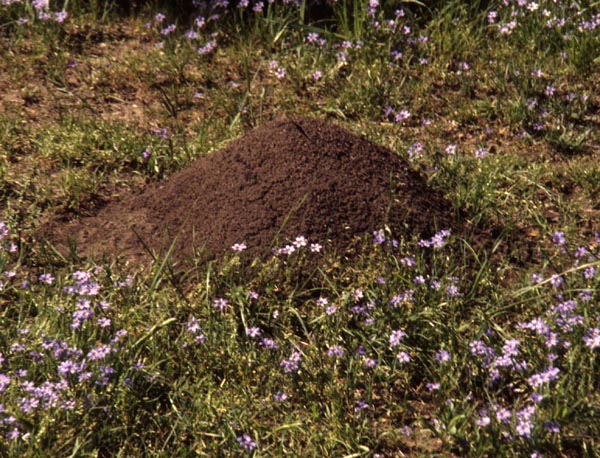
Alate female fire ant

Alate female fire ant
The red imported fire ant arrived in the US in the late 1930s in
the ballast (e.g. dirt) of a ship from Brazil that docked in Mobile, AL.
The fire ant became established in this country, and began expanding its
range in the deep south. It arrived in north Texas in the 1970s, and in
Grayson county in the mid 1980's (there were no fire ants at the college's
Sneed Environmental Research Area in 1985, but they had arrived in force
by 1993). The fire ant has continued to expand its range northward and
westward, and now occupies a large part of the southeast and south central
part of the US.
Ants in general are what biologists call "social insects", meaning that they live in organized groups of individuals, the individuals being more or less closely related genetically (e.g. an ant colony is a large extended family - we will return to this point later). In the typical ant colony, the queen is to mother of the colony, and the workers are the daughters of the queen. For genetic reasons that I hope to make clear later, the workers are better off genetically helping their mother produce sisters than they would be by producing daughters of their own. This means that ant workers are genetically predisposed to be "altruistic" or to cooperate with one another and with the queen to behave in ways that help the colony as a whole survive and reproduce. This also means that worker ants of the more advanced ant species are sterile.
If the workers are sterile, and the queen produces the workers, how does the colony reproduce (e.g. produce daughter colonies)? At certain times of the year (or in the case of the fire ant, almost any time), an ant colony produces "alates". These are ants that have wings (hence the name), that are both males (drones) and females (potential new queens). The alates fly out of the colony, form swarms where drones mate with new queens. The queens subsequently descend to the ground, where they attempt to dig a burrow, which will be the beginnings of a new ant colony. The drones mate (if they are lucky) and then die. Many, maybe most, of the alate queens die also before establishing new colonies (which is good because otherwise we would be up to our butts in fire ants).
The queens that reach the ground and establish burrows (no longer alate because they lose their wings when they start to dig burrows) eventually lay eggs which will hatch to form the first brood of workers. Once a new queen has a group of daughters to help her, she no longer forages or digs the workers perform these tasks, and feed and tend the queen. The queen's role in the life of the colony is to lay eggs (to produce workers, new alate queens, and new drones) and to direct the activities of the colony, which she does with chemical signals called pheromones.
Typical fire ant mound. These are about half a meter in diameter and 30 cm high.

Fire ants are called that for obvious reasons. Their sting is quite painful, and in sensitized people can leave small welts that are sore and itchy for several days. Of course all ants sting, and some have particularly powerful stings. Ant venoms are produced by venom glands in the abdomen, and are injected into prey or enemies with a modified ovipositor (egg-laying apparatus), so only female ants sting (this is true of other stinging Hymenoptera). Ant venoms typically include both neurotoxic and histolytic proteins, so cause both paralysis and tissue destruction in small animals that are common prey of predaceous ants. Fire ants add an alkaloid component that causes the "fire" of the sting. Another aspect of fire ant venom is that it contains a substance that recruits sister ants when one of them stings, so that typically lots of fire ants sting you at once. This behavior is reinforced by alarm pheromones which serve to alert ants to the presence of danger, and also function in recruitment.
Obviously fire ants are an exotic species that was accidentally introduced
into this country. One of the big problems with the fire ant is that there
are no natural predators here, so there is essentially nothing to keep
their numbers in check. Fire ants are a serious problem, both for humans
and their agriculture and for the native biota. Fire ants interfere with
ranching and sheep-herding (and other forms of animal husbandry) more than
with farming, but fire ant mounds may also cause problems with plowing,
planting, and harvesting crops. The effect of the fire ant on native vertebrates
and invertebrates is a subject of much scientific research. The consensus
seems to be that fire ants have caused population declines in many small
ground dwelling vertebrates from herps to birds to mammals, and that they
have had the same effect on some invertebrates. However, some animals seem
to be more or less unaffected by fire ants, and others had declined in
population size before the arrival of fire ants. Because there are no natural
predators or other population controls in this country, fire ants have
had free run of habitats. Because they are voracious and effective predators,
they have undoubtedly had a detrimental effect on much of the native fauna.